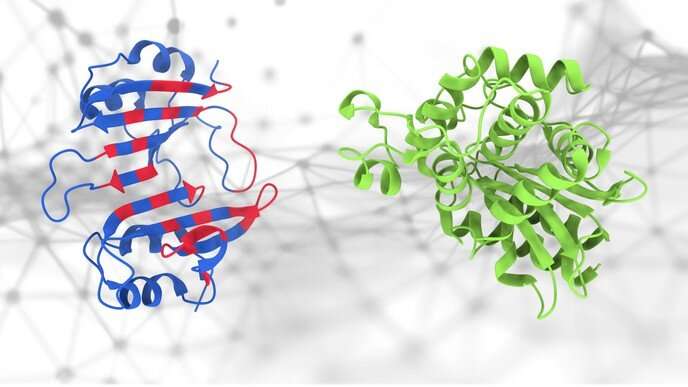This article has been reviewed according to Science X's editorial process and policies. Editors have highlighted the following attributes while ensuring the content's credibility:
fact-checked
peer-reviewed publication
trusted source
proofread
PeSTo: A new AI tool for predicting protein interactions

Scientists at EPFL have developed PeSTo, an AI model that can predict, with high confidence, the binding interfaces of proteins when they bind other proteins, nucleic acids, lipids, ions, and small molecules. The model's low computational cost enables the processing of large amounts of structural data, opening up opportunities for new biological discoveries. The research is published in the journal Nature Communications.
Proteins are essential to the biological functions of most living organisms. They have evolved to interact with other proteins, nucleic acids, lipids etc., and all of those interactions form large, "supra-molecular" complexes. This means that understanding protein interactions is crucial for understanding many cellular processes.
In a big step forward, scientists in the group of Matteo Dal Peraro at EPFL have developed a new tool called PeSTo (short for Protein Structure Transformer) that can predict the specific regions on the surface of a protein that can interact with other proteins, but also nucleic acids, lipids, ions, and small molecules. These interfaces are crucial for the formation of supramolecular complexes and function modulation.
PeSTo is built on a neural network based on transformer technology. In the context of machine learning, a transformer is a type of neural network designed to process sequential data, such as natural language by using self-attention mechanisms to weigh the importance of different parts of the input sequence and make predictions. The technology was introduced by Google Brain in 2017 and are now at the core of many modern AI tools.
How does PeSTo work?
"The model evaluates the chemical and physical context of each atom by examining all nearby atoms," says Lucien Krapp, the main developer of PeSTo. "Using the self-attention mechanism, it focuses on significant atoms and interactions within the protein structure. It means that this method effectively captures the complex interactions within protein structures to enable an accurate prediction of protein binding interfaces."
Because PeSTo's predictions are based solely on the position in space and the type of atoms, it can make predictions without needing to describe the physics and chemistry of the protein interface using additional external methods. This eliminates the "overhead" of pre-computing molecular surfaces and additional properties, making it much faster, robust and more general than current methods.
It also means that PeSTo can run fast enough to process large volumes of protein structure data, e.g., ensembles from molecular dynamics simulations or entire foldomes. Ultimately, this enables faster discovery of interfaces that go unseen in conventional static structures resolved experimentally.
PeSTo outperforms other methods for predicting protein interaction interfaces and can predict interactions with nucleic acids, lipids, ligands, ions, and small molecules with high confidence. The model's low computational cost makes it a valuable tool for the scientific community.
PeSTo applied to the human foldome
The researchers unleashed PeSTo on the human foldome, a growing database of predicted protein structures. They analyzed the interactions that human proteins have with other molecules, and produced detailed information about the human "interfaceome"—the sum total of all protein interacting interfaces in the human body. To do this, the researchers used the AlphaFold European Bioinformatics Institute (AF-EBI) database.
The researchers have made PeSTo available in a user-friendly web server, free of charge and prior registration. The server can take any protein structure in PDB format. The predicted interfaces can be visualized directly in the browser with additional information on the confidence of the prediction on a per-residue basis.
The scientists highlight numerous advantages of PeSTo over older methods, particularly that it can work with all kinds of molecules without needing to know all the details about their chemistry and physics. This makes PeSTo a more flexible, powerful and general tool for studying molecular systems and their interactions.
More information: Lucien F. Krapp et al, PeSTo: parameter-free geometric deep learning for accurate prediction of protein binding interfaces, Nature Communications (2023). DOI: 10.1038/s41467-023-37701-8
Journal information: Nature Communications
Provided by Ecole Polytechnique Federale de Lausanne





















